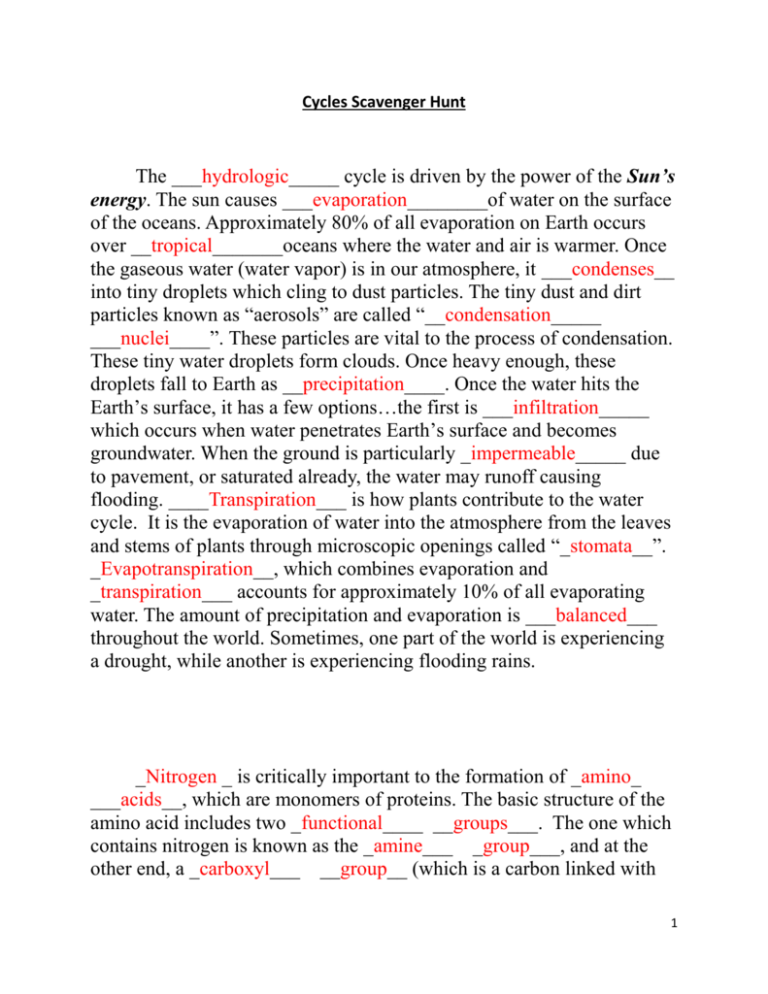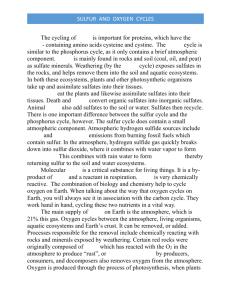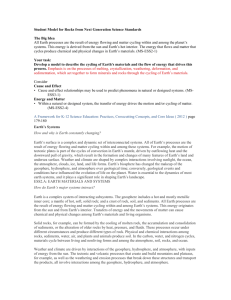Cycles Scavenger Hunt
advertisement

Cycles Scavenger Hunt The ___hydrologic_____ cycle is driven by the power of the Sun’s energy. The sun causes ___evaporation________of water on the surface of the oceans. Approximately 80% of all evaporation on Earth occurs over __tropical_______oceans where the water and air is warmer. Once the gaseous water (water vapor) is in our atmosphere, it ___condenses__ into tiny droplets which cling to dust particles. The tiny dust and dirt particles known as “aerosols” are called “__condensation_____ ___nuclei____”. These particles are vital to the process of condensation. These tiny water droplets form clouds. Once heavy enough, these droplets fall to Earth as __precipitation____. Once the water hits the Earth’s surface, it has a few options…the first is ___infiltration_____ which occurs when water penetrates Earth’s surface and becomes groundwater. When the ground is particularly _impermeable_____ due to pavement, or saturated already, the water may runoff causing flooding. ____Transpiration___ is how plants contribute to the water cycle. It is the evaporation of water into the atmosphere from the leaves and stems of plants through microscopic openings called “_stomata__”. _Evapotranspiration__, which combines evaporation and _transpiration___ accounts for approximately 10% of all evaporating water. The amount of precipitation and evaporation is ___balanced___ throughout the world. Sometimes, one part of the world is experiencing a drought, while another is experiencing flooding rains. _Nitrogen _ is critically important to the formation of _amino_ ___acids__, which are monomers of proteins. The basic structure of the amino acid includes two _functional____ __groups___. The one which contains nitrogen is known as the _amine___ _group___, and at the other end, a _carboxyl___ __group__ (which is a carbon linked with 1 oxygen and hydrogen). There are _21_ known amino acids, which in turn form all of the proteins in your body, and all other organisms’ bodies for that matter. _Enzymes___ carry out almost all of the chemical reactions in your body, and are proteins too. The chief reservoir of nitrogen on Earth is the _atmosphere___, which is about 78% nitrogen. This form of nitrogen is not assimilated by organisms besides one special group, which __fix__ nitrogen in such a way as to make it useable by other life. Nitrogen can also be __fixed__ by the action of __lightning_____, which actually “burns” it out of the atmosphere, creating __nitrate__(NO3) which is nitrogen bound to three oxygen atoms. Nitrogen fixing bacteria called rhizobium are found in the roots of __legumes___, and fix nitrogen either in the form of _nitrates__ (NO3), or _ammonia__ (NH3). Since NH3 is rather toxic, we are fortunate that there are __nitrifying____ bacteria in the soil and in the water which take up ammonia and convert it to _nitrite___, (NO2). Ammonia is also somewhat toxic, but __nitrate___ bacteria, take it and convert it to nitrate, which can be taken up by plants to continue the cycle. _Assimilation____ is the process whereby plants absorb (NH3) , _ammonium___ ions (NH4), and nitrate ions (NO3-) through their roots. Most plants can take up ___nitrate_____ and convert it to amino acids, which are, of course, the building blocks of proteins. __Heterotrophs__ acquire all of their amino acids when they eat plants (or other animals that consume plants). When organisms die and ___decompose_____, or release __waste________ the nitrogen is returned to the soil, usually in the form of __ammonia____. This NH3 or NH4 is a product of decomposing bacteria, and in this state, may be reused by plants, especially with the help of nitrate bacteria. If this is indeed a cycle…how is N2 returned to the atmosphere? It turns out that there are __denitrifying____ bacteria (usually anaerobic) which take the nitrites and nitrates and combine the nitrogen back into _N2_ gas, and nitrous oxide. This, of course, sends it back into the atmosphere to begin the cycle all over again. ___Carbon dioxide____ is a molecule that has a huge capacity to absorb great amounts of thermal energy. It is this molecule that is most 2 often attributed to global warming. The __carbon___ __cycle__ moves and stores carbon in the __biosphere____ (living subsystem), lithosphere, __hydrosphere_____(watery subsystem) and atmosphere. Carbon is stored in the biosphere as __organisms____, and in the atmosphere as _carbon___ ___dioxide __ gas. In the lithosphere, which includes the solid part of Earth’s crust, both continental and oceanic…as well as soil organic matter, you will also find Earth’s fossil fuel deposits, and sedimentary rock deposits, which are generally composed of substances like __limestone___ or calcium carbonate (CaCO3). In the oceans, rivers and streams, carbon is stored as dissolved carbon dioxide gas and as calcium carbonate shells in marine organisms (although parts of the hydrosphere overlap with the atmosphere, because remember, _water___ can exist in three states on Earth, and when it is a gas, it is in the atmosphere). Humans have altered the ___carbon____ __ cycle___ through fossil fuel burning, deforestation, and land-use change. The net result of these processes is an increasing concentration of carbon dioxide in the atmosphere. Remember, a carbon __sink___ is an area that “stores” carbon. The largest storage place for carbon on Earth is the __ocean____ and marine ___sediments_____. __Phosphorus______ is the simplest of all the nutrient cycles, as it doesn’t exist in the __atmosphere_____ for the most part…but it is found in soil, rock, and sediment. Also, of all the cycles, this one is more __local_____ rather than global… than the others. It is usually released from sediments in the form of ___phosphate___ (PO4-3), which is very __soluable_______and can be dissolved easily in water and then absorbed from the soil by plants. Phosphorus is a __limiting________ __factor_____ in the growth of plants, so plants that are exposed to minimal amounts of phosphorus are usually __stunted_______. Phosphorus is an important nutrient because it is an essential building block of _nucleic__ __acids____, which of course compose DNA and 3 ATP. Humans have affected the natural cycling of this nutrient by mining phosphorous rich rocks for __fertilizers______. When we add those to soil it interacts with the hydrologic cycle, and becomes leached out after rain, and washed to rivers and eventually into the __ocean____ where it can cause _artificial_________ _eutrophication____. The resulting _algal__ __bloom____ from artificial addition of these nutrients has a short life span. When the algae dies, it sinks to the bottom, and through the process of _decomposition__, consumes massive amounts of _dissolved_____ _oxygen___. This depletes the oxygen levels to such an extent as to rob the aquatic vertebrates and invertebrates of their oxygen source…which causes a _fish_____ __kill___. The phosphorus is simply returned to the sediment when organisms that have incorporated it into their systems die and __decompose______. The _rock___ __cycle_____ has the ability to take sediment over time and turn it into a solid through the process of lithification. Over thousands of years, a sandy beach might become part of a __sedimentary______ ___rock__ known as sandstone. Sedimentary rocks make up about three-quarters of the rocks at the Earth surface. __Fossils______ of ancient living things are preserved in sedimentary rocks too. These rocks help us solve puzzles about the past __environments______. _Igneous______ __rocks__ form when molten rock cools and becomes solid. Molten rock is called _magma___ when it is below the Earth’s surface and __lava__ when it is above. These volcanic rocks are divided into two groups, based on where the rock forms. Those that form below the Earth’s surface are called _intrusive____ igneous rocks. They form when magma enters an underground chamber, cools very slowly, and forms rocks full of large crystals. Those that form above the Earth’s surface are called __extrusive___ igneous rocks. These rocks, also 4 called volcanic rocks, form when lava cools quickly at or above the Earth’s surface and are full of _tiny___ crystals. _Metamorphic______ rocks form in a place that is very _hot__and under high _pressure____. You can find such a place where Earth's __tectonic____ plates are coming together. There, the colliding plates squish rocks, and hot pools of magma heat them deep underground. When minerals within __metamorphic_____ rock are organized a way that makes them flake apart, it is called _foliation______ . Some metamorphic rocks are _foliated____ and others are nonfoliated. The cycling of _sulfur_____is important for proteins, which have the ___sulfur__- containing amino acids cysteine and cystine. The __sulfur_____ cycle is similar to the phosphorus cycle, as it only contains a brief atmospheric component. __Sulfur______ is mainly found in rocks and soil (coal, oil, and peat) as sulfate minerals. Weathering (by the _hydrologic___ cycle) exposes sulfates in the rocks, and helps remove them into the soil and aquatic ecosystems. In both these ecosystems, plants and other photosynthetic organisms take up and assimilate sulfates into their tissues. __Consumers_____ eat the plants and likewise assimilate sulfates into their tissues. Death and __decomposition___ convert organic sulfates into inorganic sulfates. Animal __waste___ also add sulfates to the soil or water. Sulfates then recycle. There is one important difference between the sulfur cycle and the phosphorus cycle, however. The sulfur cycle does contain a small atmospheric component. Atmospheric hydrogen sulfide sources include _volcanoes___ and ___power____ __plant_____ emissions from burning fossil fuels which contain sulfur. In the atmosphere, hydrogen sulfide gas quickly breaks down into sulfur dioxide, where it combines with water vapor to form _sulfuric___ __acid___. This combines with rain water to form _acid_ __rain___, thereby returning sulfur to the soil and water ecosystems. Molecular _oxygen_____ is a critical substance for living things. It is a by-product of _photosynthesis_______ and a reactant in respiration. 5 __Oxygen____ is very chemically reactive. The combination of biology and chemistry help to cycle oxygen on Earth. When talking about the way that oxygen cycles on Earth, you will always see it in association with the carbon cycle. They work hand in hand, cycling these two nutrients in a vital way. The main supply of __oxygen__ on Earth is the atmosphere, which is 21% this gas. Oxygen cycles between the atmosphere, living organisms, aquatic ecosystems and Earth’s crust. It can be removed, or added. Processes responsible for the removal include chemically reacting with rocks and minerals exposed by weathering. Certain red rocks were originally composed of _iron___ which has reacted with the O2 in the atmosphere to produce “rust”, or _iron__ _oxide____. __Respiration___ by producers, consumers, and decomposers also removes oxygen from the atmosphere. Oxygen is produced through the process of photosynthesis, when plants use CO2 and _water___in the presence of sunlight, and generate __glucose_____ and oxygen. _Photochemical_____ ____dissociation_____ occurs when sunlight breaks down water vapor in the atmosphere, into hydrogen and oxygen. The hydrogen escapes to outer space and the oxygen remains. This oxygen can combine with diatomic molecular oxygen to produce triatomic oxygen (O3), also known as __ozone____. This gas is a vital part of Earth’s atmosphere, at least where it belongs, in an area of the __stratosphere_____ (atmospheric layer), known as the _ozone___ layer. The formation of triatomic oxygen on Earth MUST have predated the origin of life, as living cells and more complex tissue could not survive without its protective value. O3 sits in this layer and absorbs most of the incoming ultraviolet radiation, which is destructive to cells. 6









